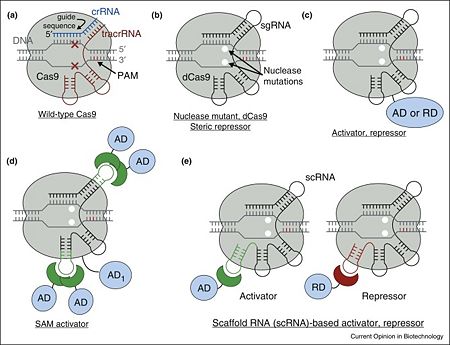Part I
SEE ALSO
Background
Highlights
- CRISPR-Cas9 (CRISPR type II-A) is a powerful tool to modulate transcription in wide range of cell types.
- An expanding set of CRISPR-based transcription effectors is available.
- Gene networks can be efficiently probed and modified for biotechnology applications.[1]
CRISPR-Cas9 has recently emerged as a promising system for multiplexed genome editing as well as epigenome and transcriptome perturbation. Due to its specificity, ease of use and highly modular programmable nature, it has been widely adopted for a variety of applications such as genome editing, transcriptional inhibition and activation, genetic screening, DNA localization imaging, and many more. In this review, we will discuss non-editing applications of CRISPR-Cas9 for transcriptome perturbation, metabolic engineering, and synthetic biology.[1]
Since the early days of genetic engineering there has been a need for control of gene expression. Naturally occurring transcription factors (TFs) have traditionally been used to achieve this goal (reviewed in [2]). However, their limited DNA binding sequence space required installing specific sequences within the transcription regulatory elements of the target genes. This can be technically difficult and may have unintended consequences on gene expression. Zinc fingers (ZFs) and transcription activator-like effectors (TALEs) were developed to overcome the fixed binding sequence requirements of native TFs. However, both ZFs and TALEs have significant limitations. ZFs have complicated design criteria and large highly repetitive TALE genes are difficult to synthesize and clone (reviewed in [3][4]). These challenges have recently been overcome using CRISPR-Cas9 based TFs. The biochemical properties of CRISPR-Cas9 based TFs that enable such flexibility and describe their applications to synthetic gene circuit design and multi-plexed perturbation of native gene networks.[1]
Transcriptional regulation with CRISPR-Cas9

Figure 1. Overview of Cas9 nuclease and dCas9-based transcription factors. (a) Wild-type Cas9 endonuclease guided by crRNA:tracrRNA to a specific site in DNA creates a double-stranded DNA break. (b) dCas9, nuclease deactivated mutant of Cas9, is an RNA programmable DNA binding protein. It can act as a steric repressor of transcription in prokaryotes and eukaryotes. sgRNA is an artificial chimeric molecule consisting of crRNA and tracrRNA molecules connected with a short loop. (c) dCas9 fusion with various transcription effectors can be used to repress or activate transcription. (d) Effector domains can be recruited by sgRNA in addition to dCas9 for enhanced activity. (e) sgRNA can be modified with specific protein binding hairpins to concurrently recruit repressor or activator domains in the same cell.
[1] Cas9 is a key protein of bacterial Type II CRISPR adaptive immune system (reviewed in [5]). In its native context, Cas9 is an RNA-guided endonuclease that is responsible for targeted degradation of the invading foreign DNA–plasmids and phages. Cas9 is directed to its DNA targets by forming a ribonucleoprotein complex with two small non-coding RNAs: CRISPR RNA (crRNA) and trans-activating crRNA (tracrRNA) (Figure 1a). In the less common class 2 CRISPR-Cas systems (types II, V, and VI), which are almost completely restricted to bacteria, the effector complex is represented by a single multidomain protein [6]. The best-characterized class 2 effector is Cas9 (type II), the RNA-dependent endonuclease that contains two unrelated nuclease domains, HNH and RuvC, that are responsible for the cleavage of the target and the displaced strand, respectively, in the crRNA–target DNA complex (, 4zt0). The type II loci also encode a trans-acting CRISPR RNA (tracrRNA) that evolved from the corresponding CRISPR repeat and is essential for pre-crRNA processing and target recognition in type II systems. Cas9 is directed to its DNA targets by forming a ribonucleoprotein complex with these 2 small non-coding RNAs: crRNA and tracrRNA. By elegant engineering, (4zt9[7]) that too efficiently directs Cas9 protein to DNA targets encoded within the guide sequence of sgRNA [8]:
Examples of 3D structures of single guide RNA (sgRNA)
The , termed the guide sequence, adjacent to a [8][9]. Despite this, a [8][10][11][12], more so within the 5’ proximal position of the guide sequence.
- (5f9r)[15].
- .
- - place of accurate, precise, and programmable DNA cleavage.
- (sgRNA is not shown).
In the type II-A system, the Cas9-tracrRNA complex and Csn2 are involved in spacer acquisition along with the Cas1-Cas2 complex [16][17]; the involvement of Cas9 in adaptation is likely to be a general feature of type II systems. Although the key residues of Cas9 involved in PAM recognition are dispensable for spacer acquisition, they are essential for the incorporation of new spacers with the correct PAM sequence [17]. The involvement of Cas9 in PAM recognition and protospacer selection [17] suggests that in type II systems Cas1 may have lost this role.
Cas9 nuclease can be converted into (PDB entry 4zt9), an RNA-programmable DNA-binding protein, by (Figure 1b) [7][1][8][9].
In the simplest case, dCas9 can repress transcription by sterically interfering with transcription initiation or elongationby being targeted to the gene of interest with a properly chosen sgRNA [8][9][10][11][18][19][20][21][22]. The repression strength is strongly dependent on the position with respect to the target promoter as well as the nature of promoter itself [10][11][18][19]. In prokaryotes, repression of up to 1000-fold was achieved when targeting dCas9 to either DNA strand within a promoter or to the non-template DNA strand downstream. However, in eukaryotic cells such steric repression is weaker: only up to 2-fold and 20-fold repression was observed with natural promoters in mammalian and yeast cells correspondingly[10][20][21]. As a notable exception, synthetic promoters specifically constructed for direct repression by dCas9 can be repressed up to 100-fold in mammalian cells[22].
Cas9-sgRNA-target DNA complexes from Streptococcus pyogenes:
Other representatives: 5y36, 4un3.
For continuation please see CRISPR-Cas9 Part II
See aslo

